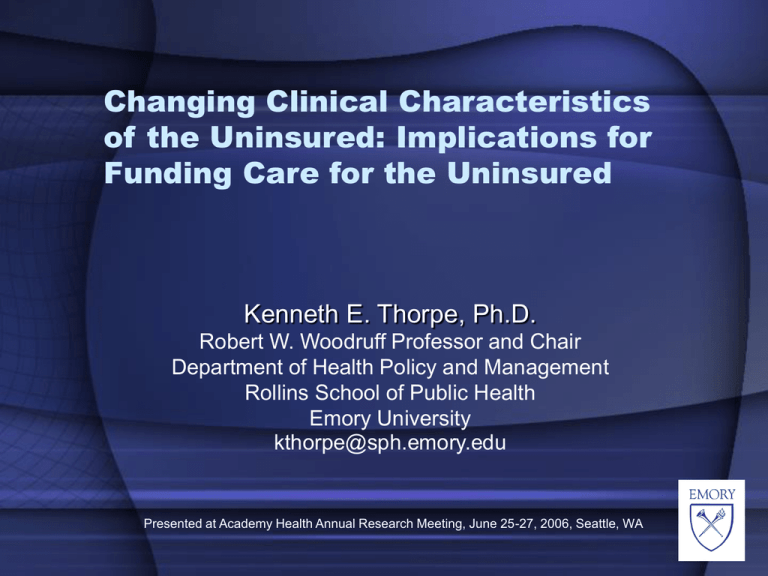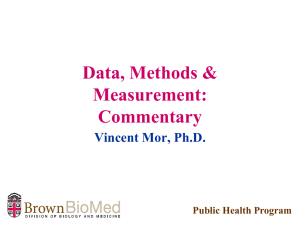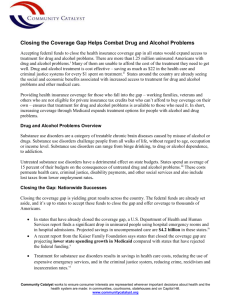Changing Clinical Characteristics of the Uninsured: Implications for Kenneth E. Thorpe, Ph.D.
advertisement

Changing Clinical Characteristics of the Uninsured: Implications for Funding Care for the Uninsured Kenneth E. Thorpe, Ph.D. Robert W. Woodruff Professor and Chair Department of Health Policy and Management Rollins School of Public Health Emory University kthorpe@sph.emory.edu Presented at Academy Health Annual Research Meeting, June 25-27, 2006, Seattle, WA Overview • Most prevalent medical conditions among the uninsured have changed over time • Largest increase in prevalence and spending associated with several chronic conditions • Observed a large increase in chronic disease prevalence among part year uninsured. This change raises major clinical management issues. • Care for many of these patient more effectively provided at better value with changes in the structure of the “safety net”. • This would entail a focus on primary care, prevention, risk appraisals, and care coordination Presented at Academy Health Annual Research Meeting, June 25-27, 2006, Seattle, WA Overview • Means “safety net” needs to be horizontally integrated rather than “hospital-only” focused. • This will require changes in how we pay for the uninsured since this episodic model of care is driven by Medicare and Medicaid DSH payment policies Presented at Academy Health Annual Research Meeting, June 25-27, 2006, Seattle, WA Overview • Current financing policy through Medicare and Medicaid DSH reinforce an inefficient, expensive model of caring for chronic care patients as it forces most care to be hospital based • Need alternative financing approaches – Pay for prevention – Pay for full coverage clinically recommended care for the uninsured (medical home concept) Presented at Academy Health Annual Research Meeting, June 25-27, 2006, Seattle, WA Storyline • How have the clinical characteristics of uninsured and Medicaid adults changed over time? • What implications does this have for the delivery and financing of care? • Examine trends from 1987 through 2003 Presented at Academy Health Annual Research Meeting, June 25-27, 2006, Seattle, WA Ten Most Prevalent Medical Conditions, Full-Year Uninsured Adults Aged 18-64, 1987 and 2003 (% Adults with condition) Conditions 1987 2003 Trauma 17.3% 8.8% Pulmonary Conditions 6.4% 6.4% Mental Disorders 4.2% 6.0% Hypertension 6.4% 5.8% Arthritis 4.4% 3.4% Diabetes 2.1% 2.8% Heart Disease 3.1% 1.8% Births 2.9% 1.5% Central Nervous 2.5% 1.9% Cancer Source: NMES and MEPS 1.4% 1.1% Presented at Academy Health Annual Research Meeting, June 25-27, 2006, Seattle, WA Most Prevalent Among Part-Year Uninsured Adults 18-64, 1987 and 2003 CONDITIONS 1987 2003 Pulmonary Disorders 8.6% 9.3% Trauma 21.6% 11.7% Hypertension 5.3% 9.4% Mental Disorders 4.7% 10.8% Osteoarthritis 4.0% 2.7% Heart Disease 4.7% 3.2% Central Nervous 3.7% 4.0% Diabetes 1.9% 3.8% Source: NMES and MEPS Presented at Academy Health Annual Research Meeting, June 25-27, 2006, Seattle, WA Most Prevalent Conditions Among Noninstitutionalized Medicaid Adults 18-64, 1987 and 2003 1987 2003 Mental Disorders 9.5% 24.9% Pulmonary Conditions 13.3% 20.0% Hypertension 12.1% 16.5% Trauma 18.7% 15.3% Births 11.4% 12.8% Osteoarthritis 11.1% 11.0% Diabetes 6.0% 10.3% Heart Disease 9.0% 8.7% Source: NMES and MEPS Presented at Academy Health Annual Research Meeting, June 25-27, 2006, Seattle, WA % Distribution of Spending, Top Medical Conditions, Full-year Uninsured Adults, 1987 and 2003, All Conditions 1987 2003 Prescription Drugs 9.5% 28.0% Inpatient Hospital 56.7% 28.8% ER 4.1% 9.2% OPP Visits 13.8% 8.4% Physicians 14.2% 25.5% Home Health 1.4% 0.1% Dental 0.3% - TOTAL 100% 100% Presented at Academy Health Annual Research Meeting, June 25-27, 2006, Seattle, WA Top Ten Most Expensive Medical Conditions, Adults 18-64, Medicaid and Full-Year Uninsured, 2003 (Billions of 2001 $) Medicaid Trauma Mental Disorders Births Pulmonary Disorders Heart Disease Diabetes Cancer Hypertension Arthritis Kidney Disease $9.3 $9.1 $7.6 $4.3 $4.8 $3.8 $3.3 $3.1 $3.2 $3.0 FY Uninsured $2.6 $1.8 $1.4 $1.7 $1.6 $0.8 $0.7 $0.9 $0.8 $0.3 Source: NMES and MPES Presented at Academy Health Annual Research Meeting, June 25-27, 2006, Seattle, WA Total $11.9 $10.9 $9.0 $6.0 $6.4 $4.6 $4.0 $4.0 $4.0 $3.3 CONCLUSIONS • Changes in clinical mix of uninsured adults leading to increase spending on prescription drugs, outpatient services and away from inpatient hospitalization (similar to private insurance trends) • Current federal DSH policies for financing care for the uninsured has not changed – retained hospital focus. Though some flexibility available through waivers • Need to re-think institutionalized based approach for financing and delivering care for uninsured • Instead focus on patient-central not provider-based approach that provides funding across full-spectrum of medical care needs Presented at Academy Health Annual Research Meeting, June 25-27, 2006, Seattle, WA




